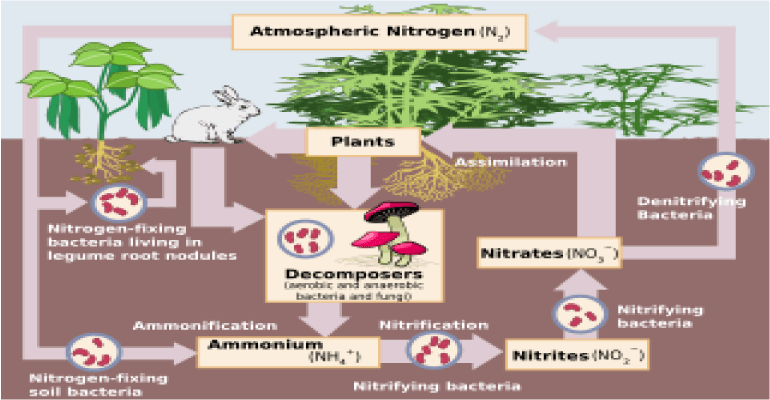
Organic nitrogen compounds such as ammonia (NH3) act as plant fertilizers. Robust plant growth consumes more atmospheric carbon dioxide during the process of photosynthesis. However, atmospheric nitrogen (N2) is relatively inert. It is converted to organic nitrogen compounds by bacteria in the top soil layers. (See nitrogen fixation) Climate models have assumed that the atmosphere is the only source of nitrogen and have therefore underestimated its fertilization effect and also underestimated the capability of plants to remove carbon dioxide from the atmosphere. New studies show that much nitrogen comes from rocks, some already in useable organic form. Weathering of rocks releases this organic nitrogen.
“A considerable amount of the nitrogen in igneous and sedimentary rocks exists as ammonium ions held within the lattice structures of silicate minerals. In sedimentary rocks, the ammonium is held by secondary silicate minerals; in igneous rocks, the ammonium is contained largely within potassium-bearing primary minerals. Analyses indicated that most of the nitrogen in igneous rocks, and from one-tenth to two-thirds of that in sedimentary rocks (shales) occurred as fixed ammonium.” (Source)
Nitrate deposits in arid and semi-arid regions provide another source of nitrogen.
“Nitrogen bearing rocks are globally distributed and comprise a potentially large pool of nitrogen in nutrient cycling that is frequently neglected because of a lack of routine analytical methods for quantification. Nitrogen in rock originates as organically bound nitrogen associated with sediment, or in thermal waters representing a mixture of sedimentary, mantle, and meteoric sources of nitrogen.” (Source)
A new study, reported by Science Daily, concerns research conducted by University of California – Davis published April 6, 2018.
“For centuries, the prevailing science has indicated that all of the nitrogen on Earth available to plants comes from the atmosphere. But a study from the University of California, Davis, indicates that more than a quarter comes from Earth’s bedrock.”
“The discovery could greatly improve climate change projections, which rely on understanding the carbon cycle. This newly identified source of nitrogen could also feed the carbon cycle on land, allowing ecosystems to pull more emissions out of the atmosphere, the authors said.”
“Geology might have a huge control over which systems can take up carbon dioxide and which ones don’t.”
“While there were hints that plants could use rock-derived nitrogen, this discovery shatters the paradigm that the ultimate source of available nitrogen is the atmosphere. Nitrogen is both the most important limiting nutrient on Earth and a dangerous pollutant, so it is important to understand the natural controls on its supply and demand. Humanity currently depends on atmospheric nitrogen to produce enough fertilizer to maintain world food supply. A discovery of this magnitude will open up a new era of research on this essential nutrient.”
Study citation: B. Z. Houlton, S. L. Morford, R. A. Dahlgren. Convergent evidence for widespread rock nitrogen sources in Earth’s surface environment. Science, 2018; 360 (6384): 58 DOI: 10.1126/science.aan4399.
Looks like “climate science” is still not settled. For instance, a 2003 study published in the same Science journal claimed, “there will not be enough nitrogen available to sustain the high carbon uptake scenarios.” Investor’s Business Daily opines: “with more nitrogen available, plant life might be able to absorb more CO2 than climate scientists have been estimating, which means the planet won’t warm as much, despite mankind’s pumping CO2 into the atmosphere.”
See also:
- Evidence that CO2 emissions do not intensify the greenhouse effect
- An examination of the relationship between temperature and carbon dioxide
- A Simple Question for Climate Alarmists
Note to readers:
- Index with links to all my ADI articles: http://wp.me/P3SUNp-1pi
- My (newly updated) comprehensive 30-page essay on climate change: http://wp.me/P3SUNp-1bq
- A shorter ADI version is at https://arizonadailyindependent.com/2013/08/01/climate-change-in-perspective/
If you like murder mysteries, type the name Lonni Lees (my wife) into Amazon or Barnes & Noble sites to see her novels, a book of short stories, and reviews. For synopses and more reviews of her books see: https://wryheat.wordpress.com/lonnis-murder-mysteries/
